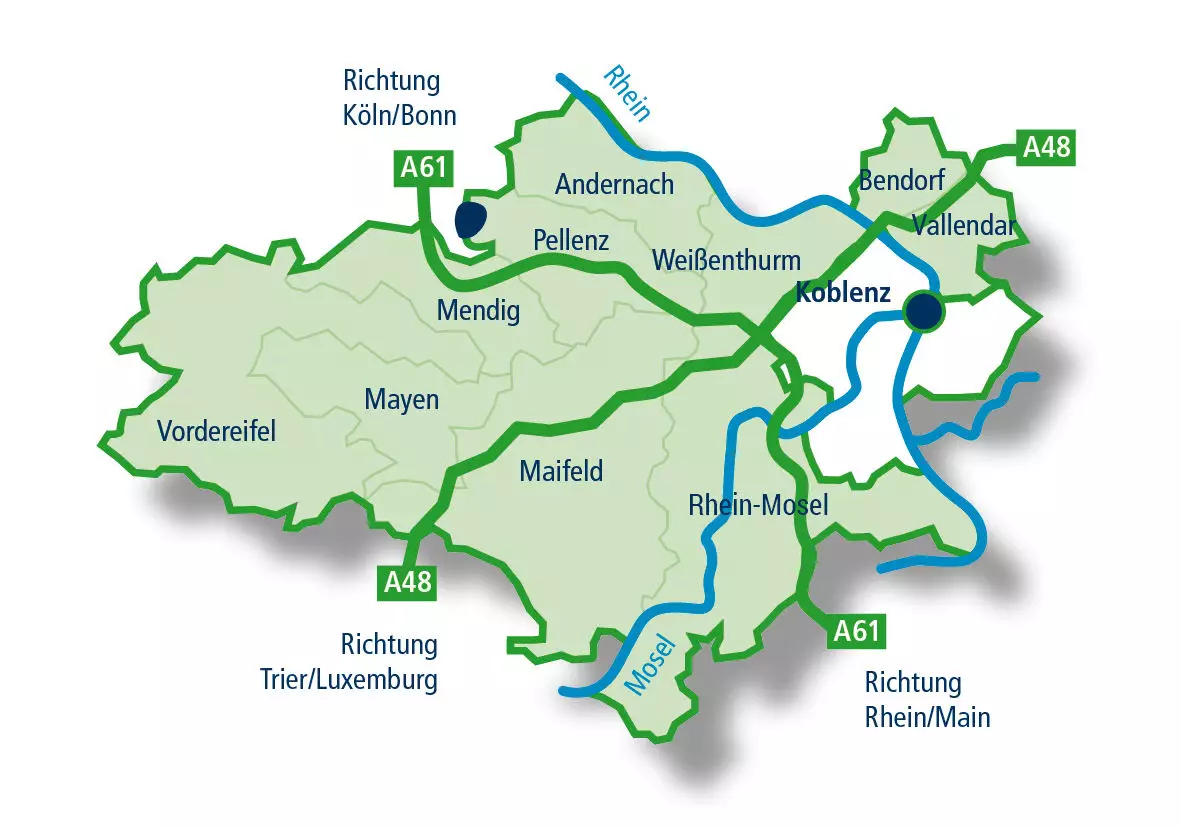In Mayen-Koblenz, the economy is thriving, with industry, commerce, trade, agriculture, viticulture and tourism all playing a part in the upturn. Charming towns and cities with pretty centres and historical buildings, a rich cultural landscape, romantic wine-growing valleys, unspoiled natural beauty, and many more places of interest all combine to give the area a particularly high quality of life.
Location Mayen-Koblenz

Over 210,000 people live in Mayen-Koblenz in the north of the province of Rhineland-Palatinate. Due to its close proximity and ready infrastructure, the independent regional centre of Koblenz is connected closely with the Mayen-Koblenz district.
The favourable geographical location of the Mayen-Koblenz district is one of the main factors that companies consider when deciding whether to set up in the area. The Mayen-Koblenz economic region offers good conditions for development, and is ideally integrated into both German and European transportation networks.
Both for traditional areas of work and newer sectors, the Mayen-Koblenz region provides forward-looking educational opportunities, which means that companies can find specialist employees both in the Mayen-Koblenz district itself and in the nearby regional centres. New blood for all major jobs are trained and educated in corporate – and sometimes private – institutions. The University of Koblenz-Landau (which offers courses in computer science, computational visualistics and information management, to name a few), the Fachhochschule (University of Applied Sciences) Koblenz and the Wissenschaftliche Hochschule für Unternehmensführung (Otto Bisheim School of Management) in Vallendar provide companies in the region with highly-skilled employees.
Building Materials and Rocks
The region's volcanically-influenced landscape is transected by the Rhine and Moselle rivers, as well as by numerous streams. There are also three large lakes in and around the Mayen-Koblenz district, including the well-known "Maar Laacher". When the volcano erupted 12,900 years ago, it deposited a thick layer of ash, pumice and rock across the region. Even shale and basalt lava are in plentiful supply below the ground. People have been mining these volcanic jewels and trading the obtained building materials and stones all around Europe for thousands of years.
Sectoral diversity
AgricultureThe building materials, minerals and slate mining industry is not the only field of work for people in the Mayen-Koblenz region. Metal processing, the food industry, mineral springs, breweries, the paper and hygiene industry, and computer technology firms are all sources of employment for the local population. Agriculture, viticulture and animal husbandry have dominated the economy in parts of the region for years. Today, there are approximately 1,200 agricultural enterprises and over 230 hectares of vines along the Rhine and Moselle rivers.
Rhine Moselle Eifel region
Castle EltzTourism represents an important market of the future for the Mayen-Koblenz region. Accordingly, the district is promoting improvements to its tourist offering (Rhine Moselle Eifel Tourism Office). Almost 8,000 beds are available to tourists during the main tourist season. Both visitors and locals alike can relax in the region's charming natural beauty, with nature reserves, protected landscapes and the Volcano Park being particular highlights. More than 400 monuments, 13 castles and palaces, numerous museums and galleries, artist groups, and concert halls characterise the region's rich culture, while all kinds of facilities, halls, swimming pools and sports facilities are available for seniors, children and sports fans to unwind or keep fit, depending on their preference.
Water, air, rail and road
There are many ways of reaching Mayen-Koblenz
Rhine Port AndernachThe district of Mayen-Koblenz lies on the Rhine and Moselle rivers, between the Rhine-Ruhr and Rhine-Main conurbations. The district is bordered by the regional centre of Koblenz, the largest city in the northern part of Rhineland-Palatinate and a "kreisfrei" or independent city in itself. Andernach, Bendorf and Mayen are the three largest towns within the actual district, which is otherwise divided into eight local authority areas.
Air Photo Rhine Port BendorfThe ports of Andernach, Bendorf and Weißenthurm, along with the port in Koblenz, are all built on Europe's largest waterway, the Rhine. The A 61 and A 48 motorways and the Koblenz motorway interchange, together with the area's other national roads, provide a link to the entire European motorway network.
ICE- Railway station Koblenz-Montabaur
In addition, the district is connected to Germany's (and Europe's) long-distance rail network by the Intercity station in Koblenz and the Intercity Express stop in Koblenz-Montabour. The rail network not only enables all major German and European cities to be reached easily: Connections in the Rhine and Moselle valleys, between Andernach and Mayen, as well as freight traffic connections on the Koblenz-Andernach-Mayen line, also guarantee the availability of supplies by rail.
Airport FrankfurtFeeder flights through the airport in Winningen ensure a good connection to the European and international flight network, while the airports in Frankfurt, Cologne-Bonn, Hahn, Saarbrücken and Luxembourg are within an hour's drive of the district.